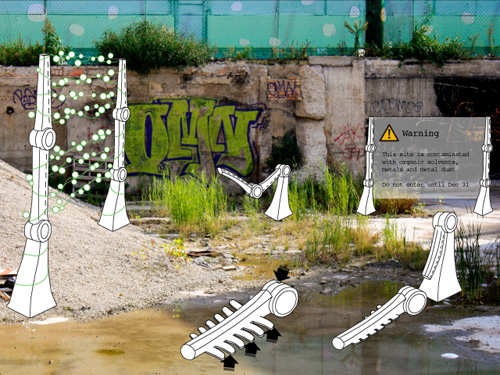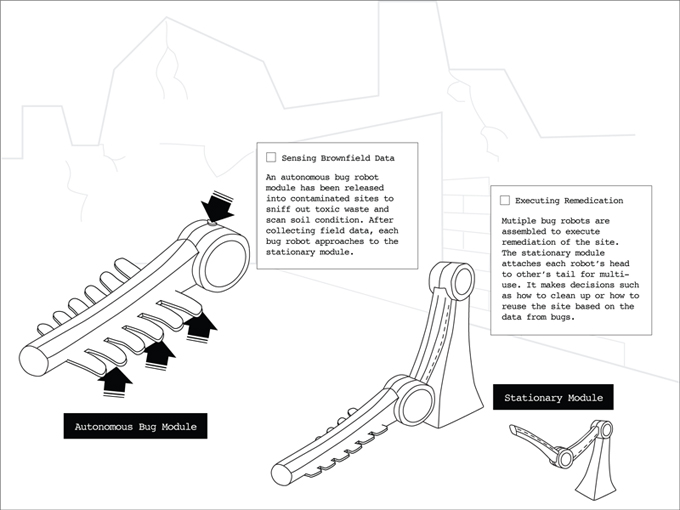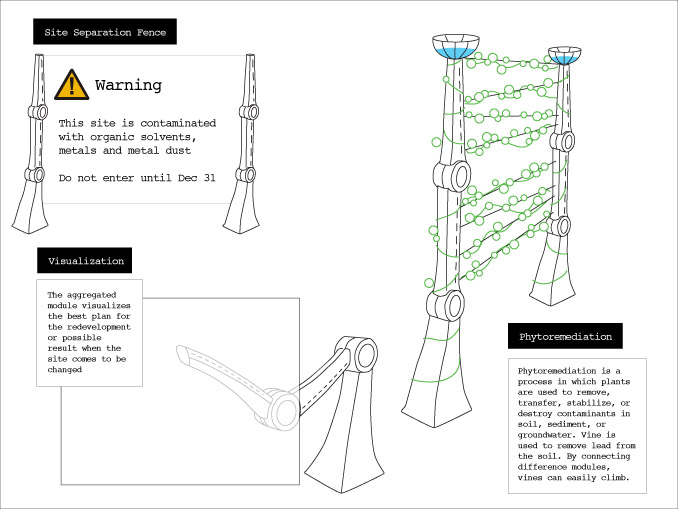 |
Urban Brownfield Remediation Robot:
A robotic module that identifies and remediates the urban brownfield, a property that is abandoned and contaminated
 |
Every modern city has an amazing amount of vacant, unused land in its downtown core-hundreds of acres in most major cities. The wasteland is referred to as a brownfield, a piece of industrial or commercial property that is abandoned, idle, or under-used and often environmental contaminated, especially one considered as a potential site for redevelopment. How do we reclaim the brownfield for the neighborhoods in a way that is flexible and contextually appropriate to the site in question? The Urban Brownfield Remediation Robot is therefore to evaluate brownfield sites and to transform the site into viable and environmentally responsible sites. Though remote sensing, each robot module analyzes brownfield sites by collecting the data necessary such as Volatile Organic Components (VOCs). The data allows the robot to decide the best remediation plan for the site. The aggregated robot modules execute possible remediation solutions from building a site separation fence to creating phytoremediation machine.
 |
The Urban Brownfield Remediation Robot is made up of autonomous bug modules and a stationary module that is a joint part of those bug modules.
(1) Autonomous bug modules: Sensing brownfield data
Automonous bug module extractes biological materials directly from the environment to facilitate ongoing and future analyis. Multiple bug modules have been released into contaminated sites to sniff out toxic waste and scan soil condition by detection of VOCs (Volatile organic compound). Once it collects data, each bug module approaches to the stationary module to synthesize data and execute remedication practice.
(2) Stationary Module: Executing remediaation practice
Mutiple bug modules are assembled to practice redemiation of the investigated site. The stationary module attaches each module's head to other's tail for multi-use in any context. It makes decisions such as how to clean up or how to reuse the site based on the data from bug modules.
 |
Evaluation of the site affects the modules in terms of their formation or function.
(1) Site seperation fence
If the site is need to be blocked due to severe contimination, the modules are formed as a site seperation fence to isolate the site until the end of remediation.
(2) Visualization
The aggregated module visualizes the best plan for redevelopment, or shows possible results when the site comes to be changed.
(3) Phytoremediation
Phytoremediation is a process in which plants are used to remove, transfer, stabilize, or destroy contaminants in soil, sediment, or groundwater. Vine is used to remove lead from the soil. By connecting difference modules, vines can easily climb.